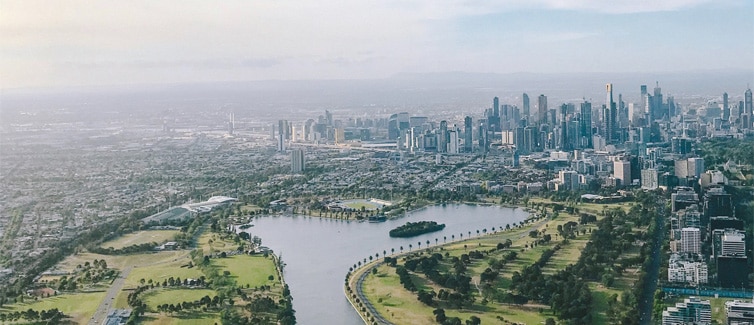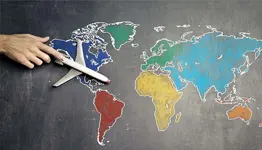

Melbourne is Australia’s top city for international students, and consistently scores highly on all major urban qualities such as healthcare, cultural events, environmental conditions, educational facilities and infrastructure. It is no surprise that for the fourth year in a row, Melbourne has been named among the world’s most liveable cities.
When you study in Melbourne, you will enjoy a safe and vibrant city that offers world-class study options, services and the widest range of things to do in terms of sports, art, music and many other activities.
Melbourne is the second-most populous city in Australia and the capital of the Australian state of Victoria. It has a population of over 5 million people, which is nearly 20% of the entire Australian population. Melbourne is also home to five of Australia’s top 20 universities, and two Melbourne universities are ranked in the global top 100. Aside from being a popular choice for international students, Melbourne is also one of the world’s financial centres.
Melbourne is located by the sea in Australia’s south-eastern region, and is well-connected by road, train and flights to other Australian cities and regions. Flights from Melbourne to New Delhi take approximately 12 hours, while direct flights from London to Melbourne take about 21 hours. For African international students, flights from Cape Town to Melbourne take about 12 to 13 hours. The city follows Australian Eastern Daylight Time which is 11 hours ahead of Greenwich Mean Time (GMT +11).
Melbourne is currently home to 7 public universities, and has satellite campuses belonging to five other universities. Three Melbourne-based universities – Monash University, Royal Melbourne Institute of Technology (RMIT) and University of Melbourne – have large student populations of over 70,000 each, forming over 60% of the city’s overall student population of 340,000. Of these, nearly 140,000 are international students such as you who have found Melbourne perfect for building their professional and academic careers. Below is a list of the some of the public universities that have a campus in and around Melbourne:
It is important to note that Monash University and the University of Melbourne are also members of the prestigious ‘Group of Eight‘, a group which comprises Australia’s ‘leading research-intensive universities.’ The Group of Eight was formed in 1999 and 7 of its 8 universities are ranked in the world’s top 100 universities.
Melbourne offers a wide range of internationally-recognised universities, with 6 Melbourne-based universities ranking among the world’s best. The University of Melbourne, for instance, is the highest-ranked Australian University and ranks in the top 3 overall in the Asia-Pacific region.
Melbourne universities are renowned for their top-quality research infrastructure as well as engaged and highly-respected teaching staff in a variety of academic areas. Melbourne universities offer world-class courses across undergraduate and graduate disciplines, and some of the most popular courses for Melbourne’s international students are:
Each of these courses is taught in one or more of Melbourne’s universities using a top-ranked research curriculum which allows you to learn both inside the classroom and outside in practical or experimental environments.
You can choose either a university with a special focus such as engineering courses at RMIT, or apply to a university such as the University of Melbourne where you can try different subject areas and eventually find your academic and professional career path. Melbourne universities are also known for providing full-time support to international students in every important aspect of student life including language learning, housing and tuition support.
Melbourne is known for its research and development capabilities which attract major multinational companies (MNCs) to set up offices in the city. Melbourne is also a key financial centre for Australia.
Many postgraduate courses in Melbourne’s top universities have long-standing ties with industry-leading companies, and studying in Melbourne will provide you with many opportunities to set up professional relationships through internships, networking events etc. which will greatly boost your career prospects. The La Trobe University Business School, for example, is headquartered in Melbourne’s financial district and provides access to world-class financial firms on a daily basis.
After studying in Melbourne as an international student you can obtain one of three different visas to begin working as a professional:
Studying abroad can be fantastic for your perceived employability. Employers will be impressed that you are willing to go outside of your comfort zone and meet new people in new situations.
As an international student, it is important that you choose a city where your safety is never in doubt and you feel comfortable in a multicultural environment. Melbourne’s multicultural city life is one of the key reasons for its large international student population. Indeed, nearly 35-40% of the city’s entire population comprises immigrants. There is a large variety of people from many different international backgrounds, and some areas of Melbourne are even known as international hubs such as the Italian community in the suburb of Carlton.
With tens of thousands of Indian, Chinese, and other international students around you, you will always feel comfortable in a home away from home, and this comfort will allow you to fully focus on excelling in academic and professional fields during your study in Melbourne. As for safety, The Economist Intelligence Unit awarded Melbourne a score of 87.30 on the Safe Cities Index last year, and it ranked fifth worldwide.
Aside from the cultural and educational quality of Melbourne, international students are also attracted by the relatively affordable tuition, housing and food costs of living in the city. Since all 7 of Melbourne’s universities are public institutions, meaning funded primarily by the government, they offer lower tuition costs than comparable private institutions in other countries such as The United States and United Kingdom.
Tuition costs in Australia are based on the amount and level of courses taken for a degree. This means that tuition costs in Melbourne can vary for international students depending both on the program selected and also on the specific courses as part of the degree program. The typical range of tuition costs is between $20,000 and $45,000 for an undergraduate degree in Melbourne. Master’s programs and other specific professional degrees are more expensive, and start at around $15,000 to $20,000 per year.
There are also plenty of scholarship and funding options for international students wishing to study in Melbourne. For detailed information about what opportunities might be available to your, contact your chosen university.
In addition to tuition costs, the monthly cost of a shared accommodation for international students can be between $400 and $600 per month. As for public transport, Melbourne is a well-connected city, but public transport is relatively expensive at around $120-150 a month. Meanwhile, you will manage to keep costs low for food and utilities at around $400-500 a month.
Overseas Student Health Cover (OSHC) Insurance is compulsory for international students at Melbourne universities. Health insurance prices can vary depending on your health circumstances and level of cover required.
Another way for international students to financially support themselves in Melbourne is to find part-time employment. International students are allowed to work up to 20 hours every week during the semester in Melbourne, and can pursue full-time work during summer and winter breaks. Many international students find part-time employment in various university offices such as research magazines, campus-wide cafes and sporting facilities.
Melbourne has plenty of cultural spaces and hospitality venues which offer part-time work at reasonable wages to international students. Many business students also choose to pursue internships at some of Melbourne’s top multinational firms, either during the semester or over the summer and winter breaks.
Melbourne is Australia’s cultural capital and is an unbeatable spot for international students to enjoy themselves outside the classroom. For sport lovers, Melbourne annually hosts the Australian Open Tennis Tournament, the Melbourne Formula 1 Grand Prix, and popular cricket matches at the iconic Melbourne Cricket Ground (MCG).
Melbourne also offers some of the best food experiences for international students, due to the historical presence of multiple immigrant communities and their culinary delicacies. Carlton and Fitzroy are the Melbourne suburbs with the highest quality of restaurants and other food spots.
There are also hundreds of live music venues and theatre spaces all over Melbourne which await budding actors and music-lovers alike. With a well-connected train and tram network, as well as the recent introduction of modern app-based taxi services, most Melbourne hotspots will only be a short drive from your residence. For art and history lovers, Melbourne offers a wide range of institutions with high-quality collections. Some of these include:
On weekends and during study breaks, international students can also make short trips to other major cities in Australia, all of which are a short flight away. These include Sydney, Australia’s most populous city featuring the iconic Sydney Opera House.
Australia’s Great Barrier Reef, meanwhile, is the country’s most popular tourist destination, and international students wanting to visit the Reef can do so as part of a trip to nearby Brisbane. Those interested in politics and international affairs can visit Canberra, Australia’s political capital. Other major Australian cities include Perth, which has a population of about 2.2 million, and Adelaide which hosts nearly 1.4 million people.
With an incredible combination of world-class faculty and research facilities, affordable tuition and living costs, hundreds of top-quality entertainment venues and a genuinely multicultural atmosphere, Melbourne stands out as a great place to study for international students across a wide range of technical disciplines and professional career paths.
If you’re considering applying to Melbourne as an international student, we recommend that you select your preferred university and courses carefully, and prepare yourself for an exciting academic and cultural journey!
See our Studying in Australia directory for more information about being an international student in the country, as well as other cities, tuition fees and a full list of courses/subjects available.
Study in AustraliaBrowse our list of higher education providers in Australia.
Sign up to StudyLink.com, the home of quality study abroad advice.
Sign up now
Read our key advice article to help you make the best decision for your education and start your International study adventure.

In this article we look at how to approach choosing where in the world you would like to study.

Read StudyLink's suggestions on your first steps when deciding where to study abroad, with helpful tips to make your decision easier.

Find out more about English language tests, your options and what is required as an overseas student.

StudyLink.com take a detailed look into the costs of studying abroad and all the aspects that you should budget for when embarking on your studies.

We answer 10 common questions about applying for a student visa to help make your visa application quick and easy.

Find out more about international student visas for studying abroad, as well as how, where and when to apply for yours.

Find out more about funding and scholarships for international students, and what financial assistance might be available to you.

How to choose a course that fits you? Check our top tips on choosing which course is best for you to help you make an informed decision.
The latest articles from study abroad providers and StudyLink.com to hep you on your study abroad journey.
See more articles